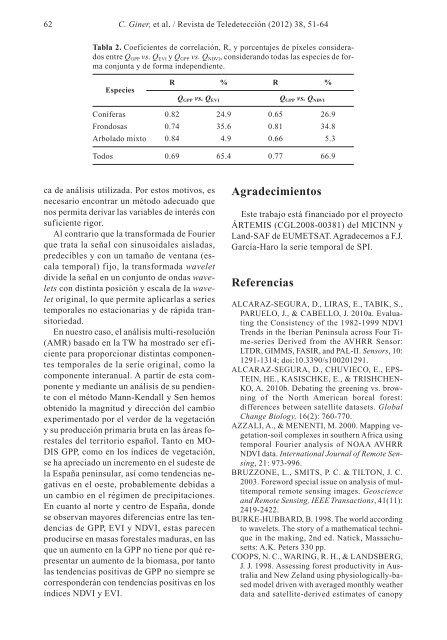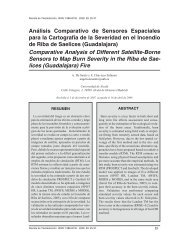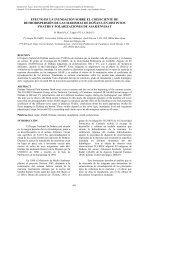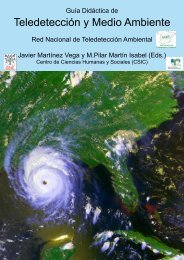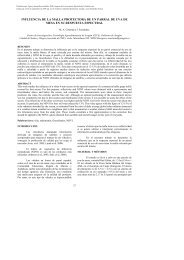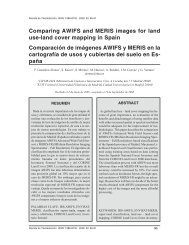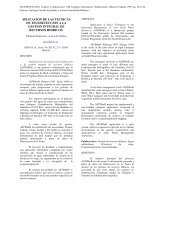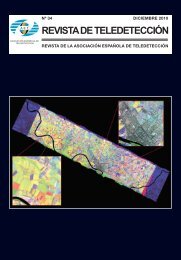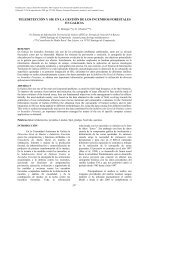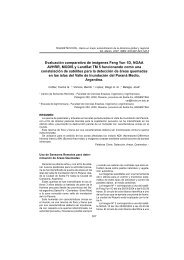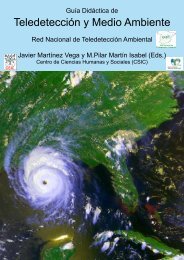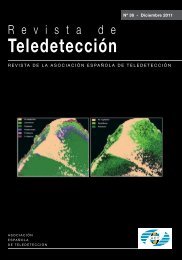00_cubiertas 38 v1 - Asociación Española de Teledetección
00_cubiertas 38 v1 - Asociación Española de Teledetección
00_cubiertas 38 v1 - Asociación Española de Teledetección
Create successful ePaper yourself
Turn your PDF publications into a flip-book with our unique Google optimized e-Paper software.
62 C. Giner, et al. / Revista <strong>de</strong> Tele<strong>de</strong>tección (2012) <strong>38</strong>, 51-64<br />
Tabla 2. Coeficientes <strong>de</strong> correlación, R, y porcentajes <strong>de</strong> píxeles consi<strong>de</strong>rados<br />
entre Q GPP vs. Q EVI y Q GPP vs. Q NDVI , consi<strong>de</strong>rando todas las especies <strong>de</strong> forma<br />
conjunta y <strong>de</strong> forma in<strong>de</strong>pendiente.<br />
Especies<br />
R % R %<br />
Q GPP vs. Q EVI<br />
Q GPP vs. Q NDVI<br />
Coníferas 0.82 24.9 0.65 26.9<br />
Frondosas 0.74 35.6 0.81 34.8<br />
Arbolado mixto 0.84 4.9 0.66 5.3<br />
Todos 0.69 65.4 0.77 66.9<br />
ca <strong>de</strong> análisis utilizada. Por estos motivos, es<br />
necesario encontrar un método a<strong>de</strong>cuado que<br />
nos permita <strong>de</strong>rivar las variables <strong>de</strong> interés con<br />
suficiente rigor.<br />
Al contrario que la transformada <strong>de</strong> Fourier<br />
que trata la señal con sinusoidales aisladas,<br />
pre<strong>de</strong>cibles y con un tamaño <strong>de</strong> ventana (escala<br />
temporal) fijo, la transformada wavelet<br />
divi<strong>de</strong> la señal en un conjunto <strong>de</strong> ondas wavelets<br />
con distinta posición y escala <strong>de</strong> la wavelet<br />
original, lo que permite aplicarlas a series<br />
temporales no estacionarias y <strong>de</strong> rápida transitoriedad.<br />
En nuestro caso, el análisis multi-resolución<br />
(AMR) basado en la TW ha mostrado ser eficiente<br />
para proporcionar distintas componentes<br />
temporales <strong>de</strong> la serie original, como la<br />
componente interanual. A partir <strong>de</strong> esta componente<br />
y mediante un análisis <strong>de</strong> su pendiente<br />
con el método Mann-Kendall y Sen hemos<br />
obtenido la magnitud y dirección <strong>de</strong>l cambio<br />
experimentado por el verdor <strong>de</strong> la vegetación<br />
y su producción primaria bruta en las áreas forestales<br />
<strong>de</strong>l territorio español. Tanto en MO-<br />
DIS GPP, como en los índices <strong>de</strong> vegetación,<br />
se ha apreciado un incremento en el su<strong>de</strong>ste <strong>de</strong><br />
la España peninsular, así como ten<strong>de</strong>ncias negativas<br />
en el oeste, probablemente <strong>de</strong>bidas a<br />
un cambio en el régimen <strong>de</strong> precipitaciones.<br />
En cuanto al norte y centro <strong>de</strong> España, don<strong>de</strong><br />
se observan mayores diferencias entre las ten<strong>de</strong>ncias<br />
<strong>de</strong> GPP, EVI y NDVI, estas parecen<br />
producirse en masas forestales maduras, en las<br />
que un aumento en la GPP no tiene por qué representar<br />
un aumento <strong>de</strong> la biomasa, por tanto<br />
las ten<strong>de</strong>ncias positivas <strong>de</strong> GPP no siempre se<br />
correspon<strong>de</strong>rán con ten<strong>de</strong>ncias positivas en los<br />
índices NDVI y EVI.<br />
Agra<strong>de</strong>cimientos<br />
Este trabajo está financiado por el proyecto<br />
ÁRTEMIS (CGL2<strong>00</strong>8-<strong>00</strong><strong>38</strong>1) <strong>de</strong>l MICINN y<br />
Land-SAF <strong>de</strong> EUMETSAT. Agra<strong>de</strong>cemos a F.J.<br />
García-Haro la serie temporal <strong>de</strong> SPI.<br />
Referencias<br />
ALCARAZ-SEGURA, D., LIRAS, E., TABIK, S.,<br />
PARUELO, J., & CABELLO, J. 2010a. Evaluating<br />
the Consistency of the 1982-1999 NDVI<br />
Trends in the Iberian Peninsula across Four Time-series<br />
Derived from the AVHRR Sensor:<br />
LTDR, GIMMS, FASIR, and PAL-II. Sensors, 10:<br />
1291-1314; doi:10.3390/s1<strong>00</strong>201291.<br />
ALCARAZ-SEGURA, D., CHUVIECO, E., EPS-<br />
TEIN, HE., KASISCHKE, E., & TRISHCHEN-<br />
KO, A. 2010b. Debating the greening vs. browning<br />
of the North American boreal forest:<br />
differences between satellite datasets. Global<br />
Change Biology, 16(2): 760-770.<br />
AZZALI, A., & MENENTI, M. 2<strong>00</strong>0. Mapping vegetation-soil<br />
complexes in southern Africa using<br />
temporal Fourier analysis of NOAA AVHRR<br />
NDVI data. International Journal of Remote Sensing,<br />
21: 973-996.<br />
BRUZZONE, L., SMITS, P. C. & TILTON, J. C.<br />
2<strong>00</strong>3. Foreword special issue on analysis of multitemporal<br />
remote sensing images. Geoscience<br />
and Remote Sensing, IEEE Transactions, 41(11):<br />
2419-2422.<br />
BURKE-HUBBARD, B. 1998. The world according<br />
to wavelets. The story of a mathematical technique<br />
in the making, 2nd ed. Natick, Massachusetts:<br />
A.K. Peters 330 pp.<br />
COOPS, N. C., WARING, R. H., & LANDSBERG,<br />
J. J. 1998. Assessing forest productivity in Australia<br />
and New Zeland using physiologically-based<br />
mo<strong>de</strong>l driven with averaged monthly weather<br />
data and satellite-<strong>de</strong>rived estimates of canopy


